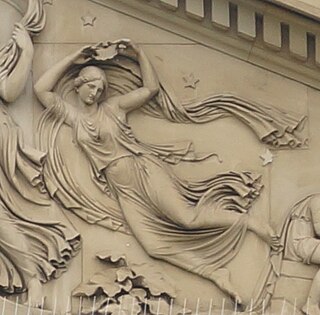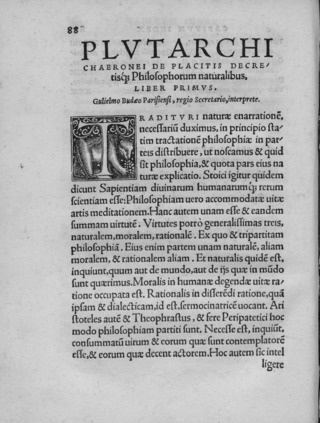Related Research Articles

Plutarch was a Greek Middle Platonist philosopher, historian, biographer, essayist, and priest at the Temple of Apollo in Delphi. He is known primarily for his Parallel Lives, a series of biographies of illustrious Greeks and Romans, and Moralia, a collection of essays and speeches. Upon becoming a Roman citizen, he was possibly named Lucius Mestrius Plutarchus.
In ancient Greek religion and mythology, Adrasteia, also spelled Adrastia, Adrastea, Adrestea, Adastreia or Adrasta, originally a Phrygian mountain goddess, probably associated with Cybele, was later a Cretan nymph, and daughter of Melisseus, who was charged by Rhea with nurturing the infant Zeus in secret, to protect him from his father Cronus. By at latest the fifth century BC, she became identified with Nemesis, the goddess of divine retribution.

In ancient Greek mythology and religion, Selene is the goddess and personification of the Moon. Also known as Mene, she is traditionally the daughter of the Titans Hyperion and Theia, and sister of the sun god Helios and the dawn goddess Eos. She drives her moon chariot across the heavens. Several lovers are attributed to her in various myths, including Zeus, Pan, and the mortal Endymion. In post-classical times, Selene was often identified with Artemis, much as her brother, Helios, was identified with Apollo. Selene and Artemis were also associated with Hecate and all three were regarded as moon and lunar goddesses, but only Selene was regarded as the personification of the Moon itself.

In Greek mythology, according to Plutarch, the 7th century BC Greek poet Alcman said that Ersa or Herse, the personification of dew, is the daughter of Zeus and the Moon (Selene). Plutarch writes:
In Greek mythology, Ochimus was the eldest of the Heliadae, sons of Helios and Rhodos.
In Greek mythology, Hegetoria was a local nymph at Rhodes who married Ochimus. They had a daughter, Cydippe or Cyrbia, who married Ochimus's brother, Cercaphus, successor to his brother's power. According to an alternate version, Ochimus engaged Cydippe to Ocridion but Cercaphus loved her and kidnapped her. He did not return until Ochimus was old.

In Greek mythology, Hellen is the eponymous progenitor of the Hellenes. He is the child of Deucalion and Pyrrha, and the father of three sons, Dorus, Xuthus, and Aeolus, by whom he is the ancestor of the Greek peoples.
Black soup was a regional cuisine of ancient Sparta, made with boiled pork meat and blood, using only salt and vinegar to flavour. The soup was well known during antiquity in the Greek world, but no original recipe of the dish survives today. The earliest recorded mention of the soup can be dated to the fifth century BC, in a comedy titled The Miners, written by Pherecrates. The ancient sources provide contradictory accounts on whether the soup was a luxurious meal served only at banquets or a dish that could be afforded by all Spartiates. Throughout history, black soup has been praised by and associated with figures such as Benjamin Rush and Adolf Hitler although Hitler was vegetarian.

In Greek mythology, Chrysippus was a divine hero of Elis in the Peloponnesus (Greece), sometimes referred to as Chrysippus of Pisa.

Timocreon of Ialysus in Rhodes was a Greek lyric poet who flourished about 480 BC, at the time of the Persian Wars. His poetry survives only in a very few fragments, and some claim he has received less attention from modern scholars than he deserves. He seems to have composed convivial verses for drinking parties. However, he is remembered particularly for his bitter clashes with Themistocles and Simonides over the issue of his medizing, for which he had been banished from his home around the time of the Greek victory at the Battle of Salamis. He was also an athlete of some distinction and reputedly a glutton.

The Parallel Lives is a series of 48 biographies of famous men written by the Greco-Roman philosopher, historian, and Apollonian priest Plutarch, probably at the beginning of the second century. It is also known as Plutarch's Lives ; Parallels ; the Comparative Lives ; the Lives of Illustrious Men ; and the Lives of the Noble Greeks and Romans. The lives are arranged in pairs to illuminate their common moral virtues or failings. The surviving Parallel Lives comprises 23 pairs of biographies, each pair consisting of one Greek and one Roman of similar destiny, such as Alexander the Great and Julius Caesar, or Demosthenes and Cicero. It is a work of considerable importance, not only as a source of information about the individuals described, but also about the times in which they lived.
In Greek mythology, Macris was a daughter of Aristaeus and Autonoe.

Bion of Borysthenes was a Greek philosopher. After being sold into slavery, and then released, he moved to Athens, where he studied in almost every school of philosophy. It is, however, for his Cynic-style diatribes that he is chiefly remembered. He satirized the foolishness of people, attacked religion, and eulogized philosophy.

The Moralia is a group of manuscripts written in Ancient Greek dating from the 10th–13th centuries but traditionally ascribed to the 1st-century scholar Plutarch of Chaeronea. The eclectic collection contains 78 essays and transcribed speeches. They provide insights into Roman and Greek life, but they also include timeless observations. Many generations of Europeans have read or imitated them, including Michel de Montaigne, Renaissance Humanists and Enlightenment philosophers.
Idomeneus of Lampsacus was a friend and disciple of Epicurus.

Harold Fredrik Cherniss was an American classicist and historian of ancient philosophy. While at the Institute for Advanced Study in Princeton, he was said to be "the country's foremost expert on Plato and Aristotle."
Pseudo-Plutarch is the conventional name given to the actual, but unknown, authors of a number of pseudepigrapha attributed to Plutarch but now known to have not been written by him.
In Greek mythology, Delphyne is the name given, by some accounts, to the monstrous serpent killed by Apollo at Delphi. Although, in Hellenistic and later accounts, the Delphic monster slain by Apollo is usually said to be the male serpent Python, in the earliest known account of this story, the Homeric Hymn to Apollo, the god kills a nameless she-serpent (drakaina), subsequently called Delphyne. According to the Suda, Delphi was named after Delphyne.
Aeinautae were magistrates at Miletus around 600 BC, consisting of the chief men in the state, who obtained the supreme power on the deposition of the tyrants, Thoas and Damasenor. Whenever they wished to deliberate on important matters, they embarked on board ship, put out at a distance from land, and did not return to shore until they had transacted their business.
Deïmachus may refer to several figures in Greek mythology:
References
- ↑ Helmbold, Nancy P. "Helmbold, William Clark". Database of Classical Scholars. Rutgers–New Brunswick School of Arts and Sciences.
- ↑ Briggs, Ward. "Nancy Pearce Helmbold". The Classical Association of the Middle West and South.